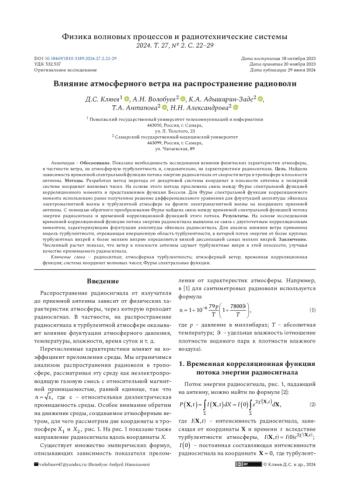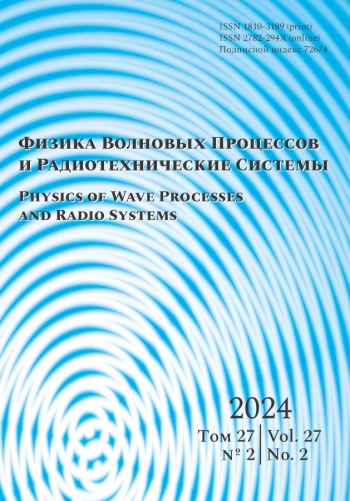Обоснование. Показана необходимость исследования влияния физических характеристик атмосферы, в частности ветра, на атмосферную турбулентность и, следовательно, на характеристики радиосигнала.
Цель. Найдена зависимость временной спектральной функции потока энергии радиосигнала от скорости ветра в тропосфере в плоскости антенны.
Методы. Разработан метод перехода от декартовой системы координат в плоскости антенны к полярной системе координат волновых чисел. На основе этого метода прослежена связь между Фурье спектральной функцией корреляционного момента и представлением функции Бесселя. Для Фурье спектральной функции корреляционного момента использовано ранее полученное решение дифференциального уравнения для флуктуаций амплитуды эйконала электромагнитной волны в турбулентной атмосфере на фронте электромагнитной волны на координате приемной антенны. С помощью обратного преобразования Фурье найдена связь между временной спектральной функцией потока энергии радиосигнала и временной корреляционной функцией этого потока.
Результаты. На основе исследования временной корреляционной функции потока энергии радиосигнала выявлена ее связь с двухточечным корреляционным моментом, характеризующим флуктуации амплитуды эйконала радиосигнала. Для анализа влияния ветра применена модель турбулентности, отражающая инерционную область турбулентности, в которой поток энергии от более крупных турбулентных вихрей к более мелким вихрям определяется вязкой диссипацией самых мелких вихрей.
Заключение. Численный расчет показал, что ветер в плоскости антенны сдувает турбулентные вихри в этой плоскости, улучшая качество принимаемого радиосигнала.
Background. It is necessary to study the influence of the physical characteristics of the atmosphere, in particular, wind on atmospheric turbulence and, consequently, on the characteristics of the radio signal it is shown.
Aim. The dependence of the time-spectral function of the radio signal energy flux on the wind speed in the troposphere in the antenna plane is found.
Methods. A method of transition from the Cartesian coordinate system in the antenna plane to the polar coordinate system of wave numbers has been developed. Based on this method the relationship between the Fourier spectral function of the correlation moment and the representation of the Bessel function is found. For the Fourier spectral function of the correlation moment, the previously obtained solution of the differential equation for the fluctuations of the eikonal amplitude of electromagnetic wave in a turbulent atmosphere at the front of the electromagnetic wave at the coordinate of the receiving antenna is used. Using the inverse Fourier transform the relationship between the time-spectral function of the radio signal energy flux and the time-correlation function of this flux is found.
Results. Based on the study of the time-correlation function of the radio signal energy flow its relationship with the two-point correlation moment characterizing the fluctuations of the eikonal amplitude of the radio signal is found. To analyze the effect of wind, a turbulence model was used, reflecting the inertial turbulence interval, in which the energy flow from larger turbulent vortices to smaller vortices is determined by the viscous dissipation of the smallest vortices.
Conclusion. Numerical calculations have shown that such a wind in the antenna plane blows away turbulent vortices in this plane, bettering the quality of the received radio signal.
Идентификаторы и классификаторы
- Префикс DOI
- 10.18469/1810-3189.2024.27.2.22-29
- eLIBRARY ID
- 67945992











